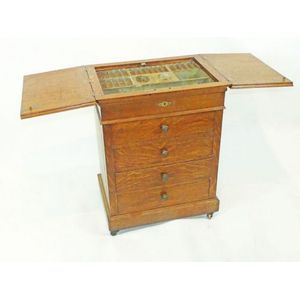Oak Artist Work Cabinet with Drawers and Metal Tray
Artists oak work cabinet having an opening top surface with metal tray insert for paints/brushes etc. As well as 4 drawer upon castors. Height 78 cm.
You must be a subscriber, and be logged in to view price and dealer details.
Subscribe Now to view actual auction price for this item
When you subscribe, you have the option of setting the currency in which to display prices to $Au, $US, $NZ or Stg.
This item has been sold, and the description, image and price are for reference purposes only.
- Castors - Wheels, fitted especially to chair legs, couches, tables and some smaller pieces of furniture, to enable them to be easily moved about. The earliest castors were of brass, with shanks fitting into the base of the leg, and the wheels often made of leather. In the late 18th century, brass 'bucket' or 'cup' castors were introduced, either rounded or square, fitting directly over the end of the leg and held in place with screws. The wheels were generally solid brass. Bucket/cup castors continued in use throughout the 19th century and indeed are still made today. In the later 19th century wheels were sometimes made of wood, china, either white or brown, and sometimes of steel.
- Oak - Native to Europe and England, oak has been used for joinery, furniture and building since the beginning of the medieval civilisation. It is a pale yellow in colour when freshly cut and darkens with age to a mid brown colour.
Oak as a furniture timber was superceded by walnut in the 17th century, and in the 18th century by mahogany,
Semi-fossilised bog oak is black in colour, and is found in peat bogs where the trees have fallen and been preserved from decay by the bog. It is used for jewellery and small carved trinkets.
Pollard oak is taken from an oak that has been regularly pollarded, that is the upper branches have been removed at the top of the trunk, result that new branches would appear, and over time the top would become ball-like. . When harvested and sawn, the timber displays a continuous surface of knotty circles. The timber was scarce and expensive and was used in more expensive pieces of furniture in the Regency and Victorian periods.
This item has been included into following indexes:
Visually similar items

A Victorian walnut casket with brass escutcheon and cartouche; paper lined. Width 28 cm
Sold by
in
for
You can display prices in $Au, $US, $NZ or Stg.

A large teak sea chest on castor wheels, 65 x 123 x 62 cm
Sold by
in
for
You can display prices in $Au, $US, $NZ or Stg.

A Regency rosewood tea caddy, sarcophagus form, the interior with two lidded compartments and an old glass mixing bowl. A.F.
Sold by
in
for
You can display prices in $Au, $US, $NZ or Stg.

Antique French brass writing box with a key, approx 13.5 cm high, 27 cm wide, 22 cm deep
Sold by
in
for
You can display prices in $Au, $US, $NZ or Stg.
